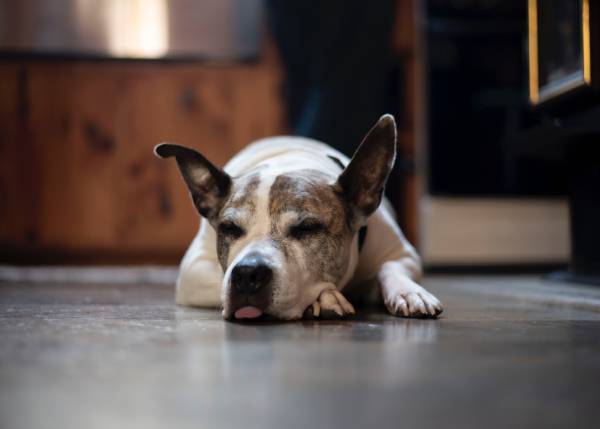Page 8 - Dog
- March 15, 2021
Previcox is prescribed for dogs that are diagnosed with osteoarthritis.
What is osteoarthritis?
Osteoarthritis (sometimes called Degenerative Joint Disease or DJD) is a progressively worsening inflammation of the joint and is caused by the cartilage in the joint deteriorating. When a joint is healthy, the cartilage acts as a cushion, and the joint moves smoothly and painlessly. With age, injury, repetitive stress, obesity or disease, the cartilage can start to deteriorate or break down. You may have noticed that your dog is “not himself”, not showing enthusiasm for your normal games or walks, or is slow in his movements.
Pets with osteoarthritis may show pain, or a decreased range of motion, and may develop inflammation or bone spurs. The joints most likely to be affected are the legs and lower back.
Because dogs are braver than us humans, your dog may not show early symptoms - but you should watch for these signs in your dog, and discuss changes with your vet:
- Stiffness,
- October 01, 2020
Parvovirus, or parvo as it more commonly known, is an extremely contagious virus that primarily affects unvaccinated puppies, puppies who are partway through their vaccination course, or unvaccinated adult dogs. Discovered in 1967, the virus had spread worldwide by 1978 and by the late 1970s, a vaccine became available.
There is no cure for parvovirus and the virus is extremely resistant to disinfectants, alcohol, heat and the cold. Parvo is one of the most serious viruses a dog can get and infection can often be fatal, especially if treatment is not started quickly enough. Any dog owner that has been unlucky enough to have a dog with parvo can tell you what a horrible disease it is. Be sure to talk to your veterinarian about making sure your dog is protected from parvo.
What is Parvo?
Parvovirus is a DNA virus. There are several types of DNA viruses that affect humans including the herpes virus that causes cold sores, the varicella-zoster virus that causes chicken pox or shingles, and
- July 14, 2020
CPR or Cardiopulmonary Resuscitation in pets is an emergency technique used when your pet has stopped breathing and they have no heartbeat. It involves rescue breathing or mouth-to-snout resuscitation and chest compressions.
Seeing your dog in a life-threatening situation can be a terrifying and stressful experience, especially if your dog is unresponsive. Arming yourself with the knowledge to effectively recognize and take action to treat your dog’s condition can help to keep you calm and greatly increase your dog’s chance of survival.
The two life-saving procedures you need to know are artificial respiration and CPR for dogs. This article will outline how to identify whether your dog needs CPR and how to perform those procedures.
1. Check For a Pulse and Breathing
Use your middle finger to find a pulse in one of the following locations:
- Below Wrist
- Inner Thigh
- Below Ankle or
- Where the elbow touches the chest
2. Check for Other Warning Signs
- Do Gums and lips appear white/gray
- March 16, 2020Since the World Health Organisation declared the 2019 novel coronavirus (also known as CoVID-19) a global health emergency, you might have been wondering if this virus could be transmitted to your pet. This article pulls information from a variety of international sources to discuss the risk of your pet becoming infected with COVID-19.
- November 08, 2019
Approximately 10% of all dogs, and 75% of senior dogs, have some form of heart disease. Heart disease can affect just one side of the heart (left or right), or sometimes it can affect both sides. It is slow to develop and can result from a genetic defect or have been caused by old age, injury, infection, poor diet or a lack of exercise.
When a dog's heart is unable to pump an adequate amount of blood around the body, this is a condition known as congestive heart failure (CHF). Congestive heart failure itself is not a disease: it is a condition that is the result of heart disease. Congestive heart failure is a fairly common condition in dogs. CHF causes an increase in both pressure and fluid in and around the heart that eventually leaks out into the lungs and sometimes elsewhere in a dog’s body. This build-up of fluid restricts a dog’s lungs and prevents them from expanding normally, thereby reducing the exchange of oxygen into the bloodstream.
What is the Difference Between Right-Sided
- October 01, 2019
Arthritis is a very common condition in humans and dogs alike. It typically affects dogs in their senior years, and certain breeds are also more susceptible than others. Osteoarthritis causes the cartilage between the bones to break down quicker and the rubbing of the bones causes inflammation and pain. Any of the joints in the body can be affected by arthritis, but is it most commonly found in the shoulders, elbows, knees or hips.
Causes of Arthritis
Aside from old age, there are a range of factors that can cause osteoarthritis to develop in your dog:
- Overweight dogs have extra strain on their joints which increases their risk of developing osteoarthritis.
- As mentioned, certain breeds are more susceptible to developing osteoarthritis. Larger breeds such as Labradors, Golden Retrievers and German Shepherds are more prone to developing osteoarthritis.
- Genetics also plays a part in whether or not a dog will develop osteoarthritis.
- If a dog sustains an injury, they can also be more prone
- September 09, 2019If there ever was a time when you wished your pet could talk, it was probably when you thought they were in pain. This article will cover the difference between acute and chronic pain and will list common signs of pain in both dogs and cats.









